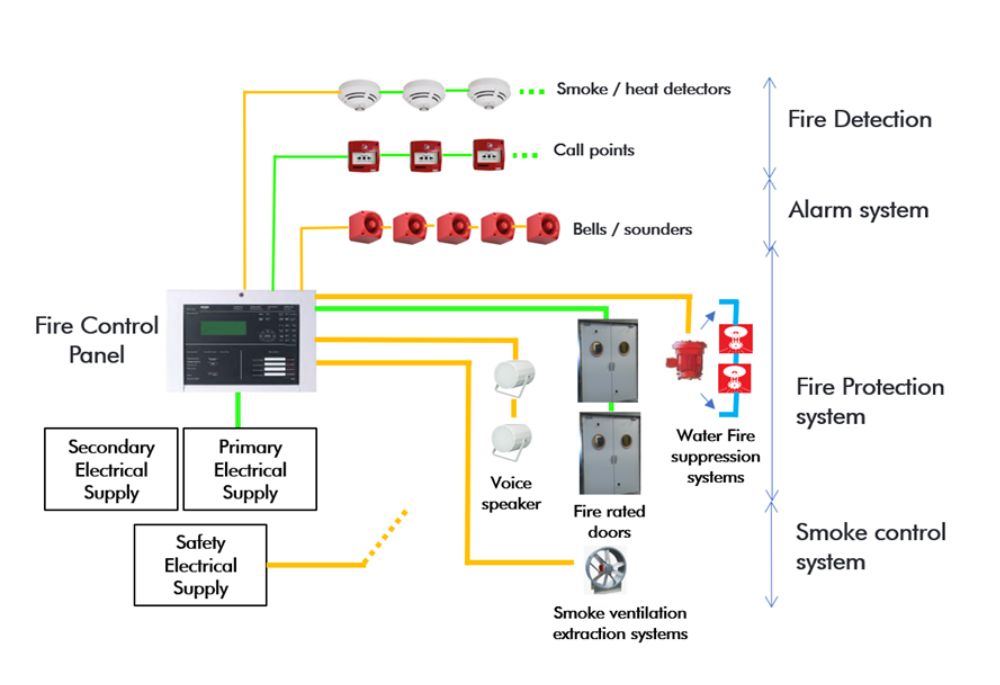How do electrical systems contribute to a safer world?
Cables are the electrical backbone of a building, being present everywhere and in large quantities to transport energy and data. They link rooms and floors, go through the walls without interruption, and their number keeps increasing with new energy usages. The fact that they are usually hidden makes it easy to forget their presence. Yet a typical office building will have over 200kg of cables per 100m². It is therefore essential to ensure that cables are as inert as possible when exposed to fire, to avoid spreading flames throughout the building.
In recent years, the emphasis has been on improving fire performance in response to new regulations, such as Europe’s Construction Products Regulation (CPR). Nexans is deeply engaged in this process, working with its partners, customers, and regulation bodies to promote electrical fire safety in buildings, and to adopt higher safety standards at both the national and international level.
Combating fire propagation
Cables do not represent a danger as such, but due to their omnipresence, they can act as fuel for fire and be a vector of flames propagation. A fire that starts in a vertical electrical installation that comprises low-performance cables will reach the first floor of the building in less than three minutes, and will continue to spread with growing speed.
At Nexans, we aim at revolutionizing the safety of buildings, infrastructures and homes, by using our technological expertise to design cables and wires that offer the highest level of performance against fire. Our Nexans Fire Safety offer underlines what can be achieved: thanks to our Low Fire-Hazard cables, smoke emissions, fire propagation and heat release are minimised. Moreover, the cohesiveness of the cable structure is maintained during fire, reducing or eliminating the production of flaming droplets, hence avoiding the start of secondary fires and limiting the risks of injury for firefighters.
All those elements have a major impact on people’s ability to evacuate safely, on time, and with the best possible visibility. In the meantime, low fire-hazard cables facilitate the work of firefighters as they release water when exposed to flame, reducing the fire temperature and diluting combustible gases.
Now a breakthrough to boost the fire performance of cables is in our pipeline. Based on geopolymer technology, this innovation works by creating a hard and hermetic crust around the stranded wires that makes them incombustible. In addition to improving fire resistance, this technology has the benefit of improving the environmental performance of cables by reducing their embodied carbon content – cutting CO2 emissions by 10 to 15% at the manufacturing level.
Smoke reduction during a fire
Smoke and hazardous emissions are the main cause of causalities during an indoor fire, being responsible for 80% of fire-related deaths. Corrosive gases in smoke attack the lungs, as well as the eyes and skin. On top of this, smoke severely limits visibility, making emergency escapes from a building more difficult.
Nexans Fire Safety range is designed to transform fire safety. Our cables minimise smoke emissions, enabling a visibility ten times higher than with traditional designs in the event of a fire – five times higher than the recommended threshold. Furthermore, they reduce the emission of hazardous and corrosive gases, increasing drastically the chance of escape, as well as assisting firefighters as they tackle the blaze.
Fire safety systems
Fire resistant cables play a crucial role in maintaining the continuous operation of fire protection and life safety electrical systems – even when a building is on fire. Minimum durations for maintaining electricity supplies in the event of fire are set out in national regulations. Cables must be capable of performing reliably even in extreme conditions, with temperatures up to 1,000°C, and for a duration up to 120 minutes.
Fire protection and life safety systems include:
- Fire detection systems: smoke detectors, heat detectors, manual call points
- Fire alarm systems: alarms/sounders, and control panels
- Fire protection systems: active (sprinkler) and passive (such as fire walls and fire-rated doors)
- Smoke control systems (pressurisation and extract systems)
- Building egress systems (including exit signage).



